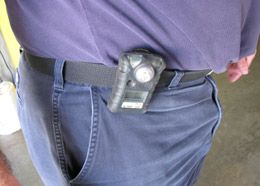By Chief Douglas Holton
Milwaukee Fire Department
 Photo Milwaukee Fire Department Milwaukee firefighters can now monitor elevated levels of CO every time they enter a home. |
Approximately one year ago, four Milwaukee Fire Department firefighters were admitted to the hospital after sustaining CO poisoning during an EMS run.
It was just one of many such incidents our department has experienced over the past few years. As a result, we have now implemented a unique initiative called the CO Meter Program, becoming the first department in the nation to launch such a scheme.
It has involved every Milwaukee Fire Department engine and truck being equipped with a single gas carbon monoxide meter. The meters are attached to the firefighters’ and paramedics’ first aid kits to accompany them on EMS runs. This helps them monitor elevated levels of CO every time they enter a home.
The incident last year exposed our firefighters to a level of 800 ppm (parts-per-million) of CO, which is 750 ppm more than OSHA standards in an eight-hour time period.
Back then there were often times our firefighters were called to a scene on an EMS run, and once they arrived determined the patient was a victim of CO poisoning. But to determine the actual level of CO on the scene, a battalion chief was called to come with a four-gas meter. If the level was more than 35 ppm, an immediate evacuation was administered.
However, wouldn’t it be safer if CO levels, evacuations and proper care for CO poisoning were done sooner rather than later, and not contingent on the arrival of a battalion chief?
This was a question posed by the MFD Joint Labor Management Safety Committee after the now one-year-old incident occurred. The committee formed and discussed how to mitigate the dangers of CO poisoning to firefighters and citizens alike.
Finding funds
The safety committee contrived the CO Meter Program from their discussions, which involved equipping each MFD truck and engine company with a single-gas meter. However, to bring the program into fruition funds had to become available.
The MFD budget set aside $8,000 for each of the 16 truck companies to receive a single-gas meter in November last year, but the task of outfitting the 37 engine companies with one was still at hand.
 We can begin to eliminate the hazard of CO poisoning to our firefighters and citizens. We can begin to eliminate the hazard of CO poisoning to our firefighters and citizens.  | ||
To make this facet of the CO Meter Program possible we sought outside funding.Within four months, our department had obtained $50,000 in sponsorships from five local companies, including a $42,000 sponsorship from the Wisconsin Energy Foundation.
The official launch of the MFD Carbon Monoxide Meter Program was March 1. From that date, all MFD ladder trucks and engine companies now have single-gas meters — MSA Altairs — to accompany them on their first aid kits on each run.
Through the program, all MFD firefighters can detect CO in a building within 15 to 30 seconds of arrival, and then take the necessary steps immediately based on the reading. The CO meters are automatically powered on and require no labor from the user other than reading the screen to check levels.
In instances where the CO meter sounds and reads below 35 ppm, our department takes the proper steps to identify the source of CO, cut it off, and keep the level from rising and becoming a potential hazard.
Each year our department has seen a steady increase in calls that result in carbon monoxide runs. With the department’s already successful CO Meter Program, we believe we can begin to eliminate the hazard of CO poisoning to our firefighters and citizens. An early example of the program’s success came April 29, when MFD Engine Company 26 and Paramedic Unit 3 received an emergency tone response for an unresponsive person. On arrival, they began to evaluate the patient and as the family began stating this was unusual behavior for them, a loud beeping noise sounded from the first aid kit. The CO meter was alarming with a reading of more than 650 ppm.
Our firefighters did an immediate evacuation and all seven people in the home, five adults and two children, were transported to the closest hospital for hyperbaric treatment related to symptoms of CO exposure.
The firefighters involved in this incident said if they were not equipped with a CO meter, it could well have been the case that only one person would have been transported to the hospital while six others would had stayed in a home filled with an extraordinary amount of a deadly gas. The probability that there would have been fatalities by morning is high.
Milwaukee Fire Chief Douglas A. Holton was sworn in as the first African American fire chief of the city of Milwaukee in June last year. Chief Holton has more than 30 years of experience in in the fire service. As fire chief of the city of Milwaukee, Chief Holton is directly responsible for supervising a staff of 10,82 firefighters, EMS, and civilian employees and overseeing a $96 million operating budget.

